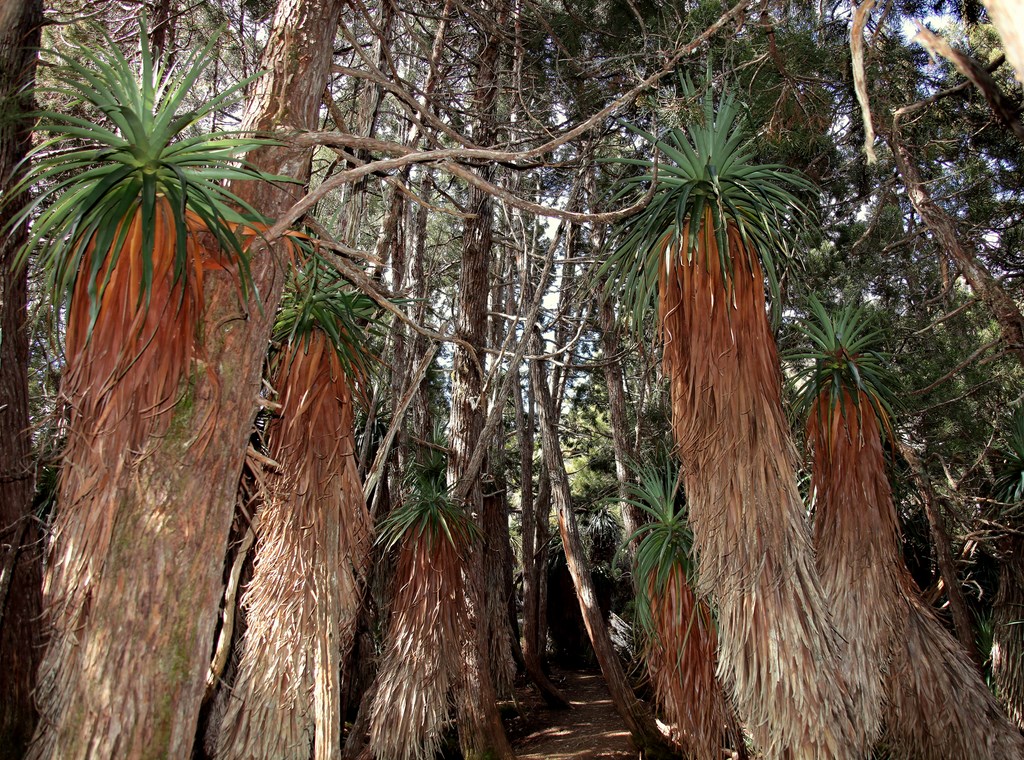RICHEA PANDANIFOLIA DOBSON LAKE
Richea pandanifolia est une espèce de plantes de la famille des Ericaceae endémique en Tasmanie.
Il a l'apparence d'un palmier, le plus souvent avec une simple tige ou parfois ramifié et mesure entre 2 et 12 mètres de hauteur. Il a des feuilles serrées les unes contre les feuilles qui se terminent en pointe. Les fleurs apparaissent en panicules, mesurant jusqu'à 25 centimètres de long et sont de couleur blanche à rose foncé.
----------------------------------
Richea pandanifolia (Pandani or Giant Grass Tree) is a species of flowering plant in the family Ericaceae, endemic to Tasmania.
Description
It is somewhat palm-like in appearance, usually growing as a single stem or occasionally branched, and is between 2 and 12 metres in height. It has densely crowded leaves which taper to a point. The flowers appear in panicles, up to 25 centimetres long and are white to deep pink.
Taxonomy
The species was first formally described by botanist Joseph Dalton Hooker in 1844 in The botany of the Antarctic voyage of H.M. discovery ships Erebus and Terror. I. Flora Antarctica . The type was reported to be growing at "Port Davy, Peak of Teneriffe, Frenchman's Cap, and several other mountainous situations".
There are two subspecies:
Richea pandanifolia Hook.f. subsp. pandanifolia
Richea pandanifolia subsp. ramulosa Menadue which was first formally described in the journal Australian Systematic Botany in 2000. The type specimen for this subspecies was collected from Newell Creek, near Queenstown.
Distribution
On the west coast, south of Strahan, Richea pandanifolia can be found growing at near sea-level in dense rainforest but rarely attains full height at these elevations. Richea pandanifolia most commonly occurs in wet mountain forests between altitudes of 600 to 1200 metres. The species is absent from the state's east coast. Easily accessible specimens can viewed at locations such as Pandani Grove at Mt Field, and Cradle Mountain via the Dove Lake and Enchanted Forest tracks.
Cultivation
Though rarely seen in cultivation, the species believed to be suitable for cool climate gardens in a moist, sheltered position with good drainage. It can also be used as a container plant. The species is more successfully propagated by seed than by cuttings.
Il a l'apparence d'un palmier, le plus souvent avec une simple tige ou parfois ramifié et mesure entre 2 et 12 mètres de hauteur. Il a des feuilles serrées les unes contre les feuilles qui se terminent en pointe. Les fleurs apparaissent en panicules, mesurant jusqu'à 25 centimètres de long et sont de couleur blanche à rose foncé.
----------------------------------
Richea pandanifolia (Pandani or Giant Grass Tree) is a species of flowering plant in the family Ericaceae, endemic to Tasmania.
Description
It is somewhat palm-like in appearance, usually growing as a single stem or occasionally branched, and is between 2 and 12 metres in height. It has densely crowded leaves which taper to a point. The flowers appear in panicles, up to 25 centimetres long and are white to deep pink.
Taxonomy
The species was first formally described by botanist Joseph Dalton Hooker in 1844 in The botany of the Antarctic voyage of H.M. discovery ships Erebus and Terror. I. Flora Antarctica . The type was reported to be growing at "Port Davy, Peak of Teneriffe, Frenchman's Cap, and several other mountainous situations".
There are two subspecies:
Richea pandanifolia Hook.f. subsp. pandanifolia
Richea pandanifolia subsp. ramulosa Menadue which was first formally described in the journal Australian Systematic Botany in 2000. The type specimen for this subspecies was collected from Newell Creek, near Queenstown.
Distribution
On the west coast, south of Strahan, Richea pandanifolia can be found growing at near sea-level in dense rainforest but rarely attains full height at these elevations. Richea pandanifolia most commonly occurs in wet mountain forests between altitudes of 600 to 1200 metres. The species is absent from the state's east coast. Easily accessible specimens can viewed at locations such as Pandani Grove at Mt Field, and Cradle Mountain via the Dove Lake and Enchanted Forest tracks.
Cultivation
Though rarely seen in cultivation, the species believed to be suitable for cool climate gardens in a moist, sheltered position with good drainage. It can also be used as a container plant. The species is more successfully propagated by seed than by cuttings.
